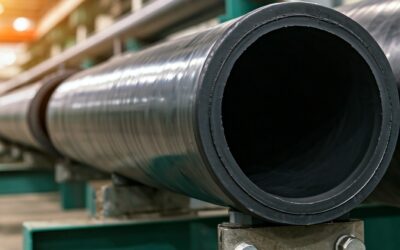Understanding durometer ratings is one of the most critical factors in selecting industrial rubber lining. A durometer measures the hardness of rubber, which directly impacts how well it performs under stress, resists abrasion, absorbs impact, and stands up to harsh environments.
Rubber hardness is critical for meeting spec requirements, ensuring long-term performance, protecting valuable equipment, and minimizing costly downtime. Whether your application involves chemical exposure, mechanical stress, or abrasive materials, the correct durometer rating can make all the difference.
In this blog, we’ll explain how durometer ratings are measured, what different levels mean, and how to match the right hardness to your specific needs.
What Is a Durometer Rating?
A durometer rating is a standardized measurement of a material’s hardness, specifically, its resistance to indentation. In industrial rubber applications, durometer ratings help engineers and maintenance teams evaluate how soft or hard a rubber compound is and whether it’s suitable for a specific environment or mechanical demand.
For most rubber lining applications, hardness is measured using the Shore A scale, which is designed for flexible, semi-rigid materials like elastomers. The scale assigns a number from 0 to 100 based on how much a calibrated device (called a durometer) penetrates the rubber’s surface:
- A lower value (e.g., Shore A 40) indicates softer rubber that absorbs shock and conforms to irregular surfaces.
- A higher value (e.g., Shore A 90) indicates harder rubber that offers greater resistance to abrasion and mechanical wear.
Hardness testing is standardized under ASTM D2240 to ensure consistency and accuracy across applications. At US Rubber, we perform durometer testing as part of our quality control process—both during manufacturing and after curing—to confirm that each lining meets its required specifications.
What Durometer Ratings Indicate in Real Applications
Different durometer ratings affect how rubber responds to stress, impact, and environmental challenges. Here’s a breakdown of what various Shore A ranges typically mean—and where each performs best.
Soft Rubber (Shore A 40–60)
- Flexible and elastic
- Absorbs vibration and shock
- Ideal for tight seals, vibration damping, and irregular surfaces
Medium Rubber (Shore A 60–75)
- Balances flexibility with strength
- Suitable for general-purpose linings
- Common in moderate-wear environments
Hard Rubber (Shore A 75–90+)
- Rigid and durable
- Resists tearing and abrasion
- Best for high-impact or high-pressure environments
Now let’s connect these characteristics to specific industrial applications:
Abrasion Resistance
Harder rubber (Shore A 80–90) withstands repeated wear, making it ideal for chutes, hoppers, and material-handling systems.
Chemical Exposure
While the compound matters most, mid-range durometer rubber (60–75) offers a good balance of flexibility and resistance in chemically aggressive environments.
Impact & Mechanical Stress
Softer rubber (40–60) performs better in shock-absorbing roles, such as vibrating screens or mobile equipment.
Complex Shapes & Surfaces
Lower durometer materials are more pliable and easier to install around bends, curves, and fittings.
Choosing a durometer that’s too hard or too soft can result in poor performance, increased wear, or even lining failure. That’s why material selection must match the real demands of your operating environment.
Why Durometer Isn’t the Only Critical Factor
While durometer ratings provide essential insight into rubber hardness, they’re just one part of the equation. The overall performance of a rubber lining also depends on:
- Rubber formulation, which affects chemical resistance, temperature tolerance, and tensile strength
- Cure systems, which influence final hardness and bonding properties
- Substrate preparation, which impacts how well the rubber adheres to surfaces
- Environmental factors like thermal cycling, pressure, and chemical exposure
Even with the right durometer, a poor fit for any of these elements can lead to premature failure. That’s why it’s important to take a holistic view—and work with a partner who understands how to optimize all the variables.
Work with US Rubber for the Right Material Selection
At US Rubber, we bring decades of experience in evaluating every aspect of your application environment, including chemical exposure, temperature extremes, mechanical stress, and abrasion levels.
Our team works closely with you to recommend the optimal durometer rating and rubber compound for your needs. And when off-the-shelf solutions won’t cut it, we can customize rubber linings to meet your exact operating conditions and performance standards.
Need help finding the right durometer rating for your lining?
Contact US Rubber today for expert guidance or to request a quote. We’re here to help you protect your equipment, reduce downtime, and get the job done right the first time.







